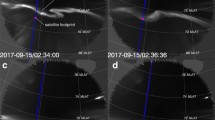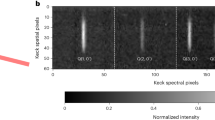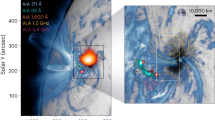Abstract
RECENT high time resolution spectroscopic studies of the aurora1 at College, Alaska, have revealed a rather consistent pattern in the spatial distribution of the hydrogen emission lines. It was observed that during the first phase of a typical polar auroral display the intensity peak of the hydrogen emission would shift in a continuous fashion from the northern horizon to the southern horizon in 1-3 hr. During nights of moderate auroral activity the intensity peak would remain near the southern horizon and then recede back to the north at the conclusion of the display, some time after midnight. Nights of strong auroral activity were characterized by the hydrogen emission features either disappearing below the local southern horizon, or being present in the entire portion of the magnetic meridian monitored by the spectrograph. The shift in zenith distance is interpreted as reflecting a change in the geomagnetic co-latitude of the incoming protons, as described below. The solid line in Fig. 1 represents typical data obtained in a six-day period.
This is a preview of subscription content, access via your institution
Access options
Subscribe to this journal
Receive 51 print issues and online access
$199.00 per year
only $3.90 per issue
Buy this article
- Purchase on Springer Link
- Instant access to full article PDF
Prices may be subject to local taxes which are calculated during checkout
Similar content being viewed by others
References
Rees, M. H., Romick, G. J., and Belon, A., Plan. and Space Sci. (in the press).
Biermann, L., Z. Astrophys., 29, 274 (1951); Z. Naturforsch., 7,a, 127 (1952); Observatory, 77, 109 (1957).
Parker, E. N., “Physics of Fluids”, 1, 171 (1958).
Van Allen, J. A., and Frank, L. A., Nature, 183, 430 (1959).
Chapman, S., and Ferraro, V. C. A., Terr. Mag. and Atmos. Elec., 36, 77, 171 (1931); 37, 147, 421 (1932).
Reid, G. C., and Rees, M. H., Plan. and Space Sci. (in the press).
Author information
Authors and Affiliations
Rights and permissions
About this article
Cite this article
REES, M., REID, G. The Aurora, the Radiation Belt and the Solar Wind : A Unifying Hypothesis. Nature 184, 539–540 (1959). https://doi.org/10.1038/184539a0
Issue Date:
DOI: https://doi.org/10.1038/184539a0
This article is cited by
-
Motion of Geomagnetic Field Lines
Nature (1961)
-
The Outer Radiation Belt and Auroræ
Nature (1960)
-
Motion of Geomagnetic Field Lines
Nature (1960)
Comments
By submitting a comment you agree to abide by our Terms and Community Guidelines. If you find something abusive or that does not comply with our terms or guidelines please flag it as inappropriate.



